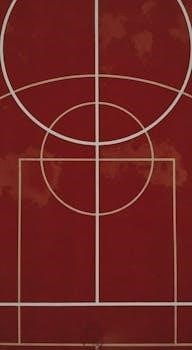Biofinity multifocal lenses provide a comfortable solution for presbyopia, offering clear vision at all distances. These monthly lenses utilize Balanced Progressive Technology, simplifying the fitting process for eye care professionals and enhancing patient satisfaction.
Overview of Biofinity Multifocal Technology
Biofinity multifocal lenses employ a unique design called Balanced Progressive Technology, which delivers exceptional vision at all distances, near, far, and intermediate. This technology optimizes visual clarity for each wearer, providing a seamless transition between different focal points. The lenses feature a center-near optical design and offer a wide range of parameters, making them suitable for a variety of presbyopic patients. Unlike some other multifocal options, the Biofinity multifocal lens does not require selection of specific add powers. Instead, the design of the lens allows for an individualized fitting for each eye, ensuring the most effective correction of presbyopia. This simplifies the fitting process, making it easier for eye care professionals to achieve successful outcomes for their patients. With this advanced technology, Biofinity multifocal lenses provide a comfortable and convenient solution for presbyopes.

Initial Fitting Process
The initial fitting of Biofinity multifocal lenses involves determining eye dominance and selecting appropriate lens parameters. This step is crucial for achieving optimal visual acuity and patient comfort.
Determining Eye Dominance
Establishing eye dominance is a critical first step in fitting Biofinity multifocal lenses, as it influences the lens power selection for each eye. Several methods can be used to determine dominance, including the sighting method, where the patient views a distant object through a small opening formed by their hands, and the blur test, which involves introducing a small amount of plus power to one eye at a time while assessing which eye tolerates the blur better. The dominant eye is typically the one that maintains clearer vision with less blur. This information helps optimize the lens fitting process, ensuring that the dominant eye is primarily used for distance vision, while the non-dominant eye is optimized for near tasks, thus maximizing binocular vision and reducing visual strain during multifocal lens wear.
Selecting the Initial Lens Parameters
Choosing the correct initial lens parameters for Biofinity multifocal lenses is essential for a successful fit, and involves considering both the patient’s refractive error and their add power. Start by using the patient’s most recent spectacle refraction, adjusting for vertex distance as needed. The appropriate add power is determined based on the patient’s near vision requirements. Biofinity multifocals feature a center-near design, so there are no specific add powers to select; instead, the lens design automatically manages the transition between distance and near vision. The fitting guide and multifocal calculator can provide a starting point, but it is crucial to consider individual patient needs and variations in ocular physiology. Selecting the correct initial lens parameters is the first step in achieving satisfactory vision and comfort.

Assessing Vision After Lens Insertion
After inserting Biofinity multifocal lenses, assess both binocular and monocular vision. Allow a 15-minute adaptation period before evaluating visual acuity at distance and near, ensuring the lenses have stabilized.
Binocular Vision Assessment
The initial step in evaluating a patient’s vision with Biofinity multifocal lenses is to conduct a binocular vision assessment. This should be done with room lights on to simulate normal viewing conditions. The goal is to determine how well both eyes work together, looking at both distance and near vision. During this stage, observe the patient’s overall clarity and comfort. Check for any signs of visual strain or imbalance. It is vital to remember that the patient’s subjective experience is crucial; therefore, ask questions about the quality of their vision. Note any complaints of blurriness, double vision, or difficulty focusing. This assessment forms the foundation for further adjustments to ensure optimal visual performance with the multifocal lenses.
Monocular Vision Assessment
Following the binocular assessment, a monocular vision assessment is crucial to understand each eye’s performance individually with the Biofinity multifocal lenses. This involves covering one eye at a time to evaluate the visual acuity of the other. Focus on both distance and near vision, noting any differences between the eyes. Assess the clarity and sharpness of vision at each distance, paying close attention to any visual distortions or blurriness. This step is crucial for identifying any imbalances or discrepancies in visual performance between the two eyes. The information gathered will guide fine-tuning adjustments to optimize the patient’s overall vision. It ensures that each eye is contributing effectively to the final visual outcome. This detailed examination helps to identify and address any specific visual needs.

Fine-Tuning the Fit
Fine-tuning is essential for optimal vision with Biofinity multifocal lenses. Over-refraction techniques are used to adjust for distance and near vision, ensuring clear and comfortable sight at all distances.
Over-Refraction Techniques
Over-refraction is a crucial step in fine-tuning Biofinity multifocal lens fits, ensuring optimal visual acuity. This technique involves using hand-held trial lenses to assess the patient’s vision with the contact lenses in place, avoiding the use of a phoropter. The goal is to refine the lens power for both distance and near vision. Start by evaluating binocular visual acuity with room lights on, then move to monocular assessment. Adjust the lens power in small increments (0.25D steps) to improve clarity. It’s important to prescribe maximum plus power for distance and adjust for near vision by adding plus or minus 0.25D increments. This method allows for a personalized fit, maximizing patient comfort and visual performance with their Biofinity multifocal lenses.
Adjusting for Distance Vision
Fine-tuning distance vision with Biofinity multifocal lenses requires a careful approach. After the initial lens fitting and over-refraction, assess the patient’s distance visual acuity. If improvement is needed, adjust the lens power in small increments, typically +/- 0.25 diopters. The goal is to achieve the best possible clarity at distance without compromising near vision. It’s recommended to prescribe the maximum plus power for distance, which can help enhance visual clarity. If the patient reports blurry distance vision, consider adding minus power in 0.25D steps. Remember to reassess binocular and monocular vision after each adjustment. This process ensures the patient can see clearly at distance while maintaining optimal vision at other focal points. Patience and precision are key to achieving the desired outcome.
Adjusting for Near Vision
Optimizing near vision with Biofinity multifocal lenses involves a similar fine-tuning process as for distance. If the patient reports difficulty with near tasks after the initial fitting, adjustments are needed. Begin by evaluating the patient’s near visual acuity using a near vision chart. To enhance near vision, consider adding plus power in 0.25D steps, up to 0.50D, to the eye requiring improvement. This adjustment helps patients see clearly up close without sacrificing their distance vision. However, it’s important to note that any change to near vision can potentially impact distance clarity. Therefore, a careful balance must be achieved. Reassess the patient’s near vision after each minor adjustment. The ultimate aim is to provide comfortable and clear vision for reading and other close-up activities. Patient feedback is crucial throughout this process.
Troubleshooting and Follow-Up
Fitting multifocal lenses can present challenges. Regular follow-up appointments are crucial to monitor adaptation and address any issues. Patient education plays a key role in successful wear and vision.
Common Fitting Challenges
Fitting Biofinity multifocal lenses can sometimes present challenges, despite their advanced design; One common issue is achieving the optimal balance between distance and near vision, which may require adjustments to the lens parameters or over-refraction techniques. Patients may also experience initial adaptation difficulties, such as fluctuating vision or mild discomfort. Additionally, determining the correct add power and addressing any astigmatism can be crucial for successful fitting. It’s important to consider individual patient needs and visual requirements to overcome these common hurdles. Careful assessment and patience are essential to ensure a comfortable fit and clear vision at all distances. Proper communication with patients is necessary to manage expectations and address concerns.
Adaptation Period and Patient Education
The adaptation period for Biofinity multifocal lenses can vary, typically ranging from a few days to a couple of weeks. Patients should be educated on what to expect during this time, including potential fluctuations in vision and mild initial discomfort. It’s crucial to emphasize that consistent wear is key to successful adaptation. Patients need to understand the importance of proper lens care and hygiene to prevent complications. Moreover, they should be informed about the lens’s progressive design and how it differs from single-vision lenses. Clear communication of the fitting process and follow-up schedule will help manage expectations and ensure a comfortable and successful experience with Biofinity multifocal lenses. Encouraging patience and addressing any concerns promptly are essential aspects of patient education.

Additional Resources
For further assistance, utilize the multifocal calculator and consult the manufacturer’s fitting guide. These tools provide detailed instructions, parameters, and troubleshooting tips to optimize the fitting process.
Using the Multifocal Calculator
The multifocal calculator is an invaluable tool for eye care professionals fitting Biofinity multifocal lenses. This digital resource streamlines the process, helping to determine the optimal lens parameters based on the patient’s refractive error and add power. By inputting specific patient data, the calculator provides a recommended starting point for lens selection, reducing chair time and enhancing fitting accuracy. The calculator is designed to simplify the complexities of multifocal lens fitting, offering a user-friendly interface that guides practitioners through each step. Furthermore, this tool assists in fine-tuning the fit, ensuring optimal visual acuity at all distances. Utilizing the calculator effectively contributes to a more efficient and successful fitting experience, ultimately leading to greater patient satisfaction with their Biofinity multifocal lenses. It is essential to cross-reference the recommendations with clinical judgment.
Manufacturer’s Fitting Guide
The manufacturer’s fitting guide for Biofinity multifocal lenses is a comprehensive resource providing detailed instructions for eye care practitioners. This guide offers a step-by-step approach to fitting, encompassing initial lens selection, vision assessment, and fine-tuning techniques. It emphasizes the importance of understanding the lens’s Balanced Progressive Technology and how it impacts visual outcomes. The guide includes specific recommendations for determining eye dominance and selecting the appropriate add power. It also provides guidance on troubleshooting common fitting challenges and adapting to the lenses. The manufacturer’s guide is essential for achieving optimal fitting success, ensuring that practitioners adhere to best practices. It’s a valuable tool that enhances the fitting process, leading to improved patient comfort and visual satisfaction with Biofinity multifocal lenses. The guide should be consulted regularly for up-to-date information.
